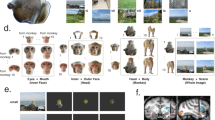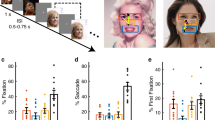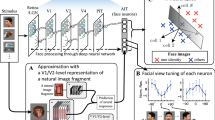Abstract
When we see a person's face, we can easily recognize their species, individual identity and emotional state. How does the brain represent such complex information? A substantial number of neurons in the macaque temporal cortex respond to faces1,2,3,4,5,6,7,8,9,10,11,12. However, the neuronal mechanisms underlying the processing ofcomplex information are not yet clear. Here we recorded the activity of single neurons in the temporal cortex of macaque monkeys while presenting visual stimuli consisting of geometric shapes, and monkey and human faces with various expressions. Information theory was used to investigate how well the neuronal responses could categorize the stimuli. We found that single neurons conveyed two different scales of facial information intheir firing patterns, starting at different latencies. Global information, categorizing stimuli as monkey faces, human faces or shapes, was conveyed in the earliest part of the responses. Fineinformation about identity or expression was conveyed later,beginning on average 51 ms after global information. We speculate that global information could be used as a ‘header’ to prepare destination areas for receiving more detailed information.
This is a preview of subscription content, access via your institution
Access options
Subscribe to this journal
Receive 51 print issues and online access
$199.00 per year
only $3.90 per issue
Buy this article
- Purchase on Springer Link
- Instant access to full article PDF
Prices may be subject to local taxes which are calculated during checkout


Similar content being viewed by others
References
Gross, C. G., Rocha-Miranda, C. E. & Bender, D. E. Visual properties of neutrons in inferotemporal cortex of the macaque. J. Neurophysiol. 35, 96–111 (1972).
Bruce, C., Desimone, R. & Gross, C. G. Visual properties of neurons in a polysensory area in superior temporal sulcus of the macaque. J. Neurophysiol. 46, 369–384 (1981).
Perrett, D. I. et al. Neurones responsive to faces in the temporal cortex: Studies of functional organization, sensitivity to identity and relation to perception. Hum. Neurobiol. 3, 197–208 (1984).
Baylis, G. C., Rolls, E. T. & Leonard, C. M. Functional subdivisions of the temporal lobe neocortex. J.Neurosci. 7, 330–342 (1987).
Hasselmo, M. E., Rolls, E. T. & Baylis, G. C. The role of expression and identity in the face-selective responses of neurons in the temporal visual cortex of the monkey. Behav. Brain Res. 32, 203–218 (1989).
Yamane, S., Kaji, S. & Kawano, K. What facial features activate face neurons in the inferotemporal cortex of the monkey? Exp. Brain Res. 73, 209–14 (1988).
Young, M. P. & Yamane, S. Sparse population coding of faces in the inferotemporal cortex. Science 256, 1327–1331 (1992).
Mikami, A., Nakamura, K. & Kubota, K. Neuronal responses to photographs in the superior temporal sulcus of the rhesus monkey. Behav. Brain Res. 60, 1–13 (1994).
Nakamura, K., Matsumoto, K., Mikami, A. & Kubota, K. Visual response properties of single neurons in the temporal pole of behaving monkeys. J. Neurophysiol. 71, 1206–1221 (1994).
Oram, M. W. & Perrett, D. I. Time course of neural responses discriminating different views of the face and head. J. Neurophysiol. 68, 70–84 (1992).
Oram, M. W. & Perrett, D. I. Integration of form and motion in the anterior superior temporal polysensory area (STPa) of the macaque monkey. J. Neurophysiol. 76, 109–129 (1996).
Tovee, M. J., Rolls, E. T., Treves, A. & Bellis, R. P. Information encoding and the responses of single neurons in the primate temporal visual cortex. J. Neurophysiol. 70, 640–654 (1993).
Kitazawa, S., Kimura, T. & Yin, PB. Cerebellar complex spikes encode both destinations and errors in arm movements. Nature 392, 494–497 (1998).
Sugase, Y., Yamane, S., Kawano, K. & Ueno, S. Neurons in the macaque temporal cortex convey multiple information about monkey and human faces with expression. Soc. Neurosci. Abs. 24, 899 (1998).
Heller, J., Hertz, J. A., Kjaer, T. W. & Richmond, B. J. Information flow and temporal coding in primate pattern vision. J. Comput. Neurosci. 2, 175–193 (1995).
Suzuki, W. A. & Amaral, D. G. Perirhinal and parahippocampal cortices of the macaque monkey: Cortical afferents. J. Comp. Neurol. 350, 497–533 (1994).
Lavenex, P., Suzuki, W. A. & Amaral, D. G. Projections from the perirhinal and parahippocampal cortices to the neocortex in macaque monkeys (Macaca fascicularis). Soc. Neurosci. Abs. 24, 1905 (1998).
Seltzer, B. & Pandya, D. N. Afferent cortical connections and architectonics of the superior temporal sulcus and surrounding cortex in the rhesus monkey. Brain Res. 149, 1–24 (1978).
Webster, M. J., Bachevalier, J. & Ungerleider, L. G. Connections of inferior temporal areas TEO and TE with parietal and frontal cortex in macaque monkeys. Cereb. Cortex 4, 470–483 (1994).
Amaral, D. G. & Price, J. L. Amygdalo-cortical projections in the monkey (Macaca fascicularis). J.Comp. Neurol. 230, 465–496 (1984).
Nakamura, K., Mikami, A. & Kubota, K. Activity of single neurons in the monkey amygdala during performance of a visual discrimination task. J. Neurophysiol. 67, 1447–1463 (1992).
Amari, S. Neural theory of association and concept-formation. Biol. Cybern. 26, 175–185 (1977).
Ellis, H. D. in The Neuropsychology of Face Perception and Facial Expression (ed. Bruyer, B.) 1–27 (Lawrence Erlbaum, London, 1986).
Hecaen, H. in Interhemispheric Relations and Cerebral Dominance (ed. Moutcastle, V. B.) 215–243 (John Hopkins, Baltimore, 1962).
McCarthy, R. A. & Warrington, E. K. Evidence for modality-specific meaning systems in the brain. Nature 334, 428–430 (1988).
Damasio, H., Grabowski, T. J., Tranel, D., Hichwa, R. D. & Damasio, A. R. Aneural basis for lexical retrieval. Nature 380, 499–505 (1996).
Panzeri, S. & Treves, A. Analytical estimates of limited sampling biases in different information measures. Network 7, 87–107 (1996).
Golomb, D., Hertz, J., Panzeri, S., Treves, A. & Richmond, B. How well can we estimate the information carried in neuronal responses from limited samples? Neural Comput. 9, 649–665 (1997).
Acknowledgements
We thank S. Kitazawa and B. J. Richmond for information analysis; M. Toshi and B.J. Richmond for critical comments on this manuscript; M. Shidara, K. Matsuda, K. Kansaku, S. Kanazawa, E. Rosenberg and S. Motoyasu for their help; and M. Okui, A. Kameyama and T. Takasu for technical assistance. This work was supported by Agency of Industrial Science and Technology, the Science and Technology Agency, and Japan Society for the promotion of science research fellowships for young scientists.
Author information
Authors and Affiliations
Corresponding author
Rights and permissions
About this article
Cite this article
Sugase, Y., Yamane, S., Ueno, S. et al. Global and fine information coded by single neurons in the temporal visual cortex. Nature 400, 869–873 (1999). https://doi.org/10.1038/23703
Received:
Accepted:
Issue Date:
DOI: https://doi.org/10.1038/23703
This article is cited by
-
Does the Emotional Modulation of Visual Experience Entail the Cognitive Penetrability of Early Vision?
Review of Philosophy and Psychology (2023)
-
Comparison of neuronal responses in primate inferior-temporal cortex and feed-forward deep neural network model with regard to information processing of faces
Journal of Computational Neuroscience (2021)
-
Rapid and dynamic processing of face pareidolia in the human brain
Nature Communications (2020)
-
What’s in a “face file”? Feature binding with facial identity, emotion, and gaze direction
Psychological Research (2017)
-
Integration or separation in the processing of facial properties - a computational view
Scientific Reports (2016)
Comments
By submitting a comment you agree to abide by our Terms and Community Guidelines. If you find something abusive or that does not comply with our terms or guidelines please flag it as inappropriate.



